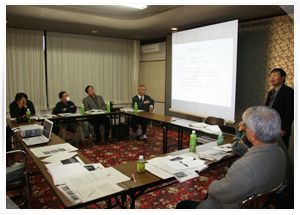

As a tangible form of material culture, mingu (folk implements) can be excellent basic materials for understanding how ordinary people around the world live in terms of their production activities and daily lives. This research group aims, in brief, to promote international adoption of the concept expressed by the word mingu through its use as a technical term and to advance studies in this area. To that end, it is necessary to establish a common nomenclature for these objects, as archeologists and historians of science and technology have done. The limits of the existing nonstandardized terms are obvious; for example, the Japanese word kago is often translated “bamboo basket,” but one can readily think of examples made of other materials and with various shapes; thus, an illustration is required for clarity. Even within Japanese, the difference between kago and zaru (sometimes translated ‘bamboo colander’) is debatable.
The background to a systematic nomenclature for mingu is complex, as the names used by each ethnic group reflect its view of nature and the world, together with such attributes as regionality, temporality, and hierarchy; it also becomes necessary to situate the names in the context of modernization. Thus, it will be far from easy to establish a common nomenclature. In the first stage, we will discuss the definition of mingu, then take several implements as indicators and explore the possibility of developing a common nomenclature, while making comparisons among Japan, East Asia, Asia as a whole, the Middle East, and Europe. In the process, we will actively introduce methods of classification and dissemination utilizing the latest advances in informatics. As a future goal, publication of an “international mingu dictionary” would aid understanding of people’s daily lives around the world as they really are.
| Name | Specialty | Affiliation | |
|---|---|---|---|
| PL | KAMINO Yoshiharu | Folklore | Musashino Art University |
| DL | SANO Kenji | Folklore | Kanagawa University |
| PM | GOTO Akira | Agricultural economics | Kanagawa University |
| PM | KAWANO Kazuaki | Japanese Folklore | Nampo Minzoku Bunka Kenkyujo |
| PM | KOH Kwang Min | Folklore | Mokpo National University |
| PM | KONO Michiaki | History from the Perspective of Mingu | ISJFC Kanagawa University |
| PM | MAJIMA Shunichi | Study of living | TEM Kenkyujyo |
| PM | SASAKI Takeo | Folklore | Fukushima Museum |
| PM | UEZU Hitoshi | Folklore | Meio University, Kumejima Museum |
| PM | YAEGASHI Jyunki | Applied informatics | Shizuoka University |
| RC | ISHINO Ritsuko | The study of Mingu | Musashino Art University |
| RC | KIM Jong Gyu | Architecture | The National Folk Museum Of Korea |
| RC | NIKKUNI Isamu | Plant ecology | |
| RC | TAKAHASHI Noriko | Japanese Folklore | Kawasaki City Museum |
- PL
- -Project leader
- DL
- -Deputy project leader
- PM
- -Project member
- RC
- -Research cooperator
